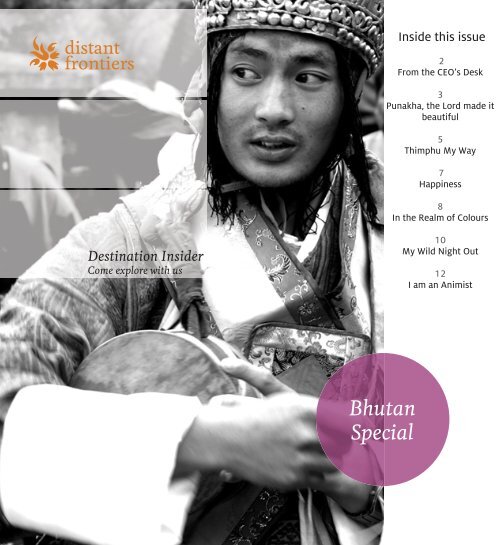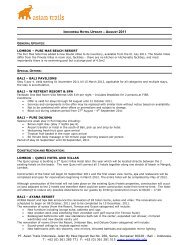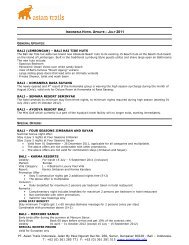Create successful ePaper yourself
Turn your PDF publications into a flip-book with our unique Google optimized e-Paper software.
Nancy E. Right's poem 'Happiness' is based on her journey to the Himalayan Kingdom of <strong>Bhutan</strong> in 2008. It won the first prize at theNorth American Festival of Wales the same year.©Happiness - Nancy E. Wright, 2008HappinessI am a small countryOn an infinite journey,Tucked between dynasties,Enfolding scarlet rhododendrons,Cascading down forested mountains,Their currents transcending current time.On an infinite journey,Stretching backward and forward,Like a tiger reclining across centuries,Reaching as far as a dragon's thunder,Lasting long like the fire of chili peppersOn the lips of my storytellersTucked between dynastiesThat trade with and invade me,I too have been kingdom and trader, defender, invader,With skirmished frontiers, I pulled myself apart,Then wiser, traded water for oil.The dynasties needed energy, and I needed warmth.Enfolding scarlet rhododendrons,Overlooking fields of asparagusAnd orchards of apples,Together oil and sunshine yield warmth and light,Modern tradition, traditionally modern,Mysterious happiness in a peaceful land.Cascading down forested mountainsAre the narratives of my life,The seeds, the buds, the blossoms cradling seedsThat must fall into rich earth to grow tall;Falling ahead and advancing back--This is what I call happiness.Their currents transcending current time,These rhododendrons are eternal,Scarlet emblems of my changeless heart,Embraced by deciduous and evergreen,More growth than progress, both falling and remaining,As lines reappear in the journey's every new verse.
Born and brought up in rural <strong>Bhutan</strong>, Ugen has lived with <strong>Bhutan</strong>'s age-old animist tradition with his joint family. Henow finds a deep connection between the ancient animist tradition and the conservation of the environment. Ugen isstrong advocate of experiential travel and sees it as an opportunity where all such quaint, but meaningful traditionscould be witnessed and kept alive. Ugen Tenzin is a friend of Distant Frontiers and works in Thimphu.I am an AnimistBon-choe, the <strong>Bhutan</strong>ese name for Animism predates Buddhism. In simple terms Animism means worship of nature.However, Bon-choe draws some negative undertones whenever mentioned since the extreme primitive practiceinvolved elements of blood sacrifice called Mar-choe. With the onset of Buddhism in the 7th century, effigy ritualscalled Kar-choe replaced the bloody sacrifices.The <strong>Bhutan</strong>ese way of life is deeply rooted in animist rituals which we are unaware as the Buddhist and Hinduphilosophies have been high-flying in the present. The animist rituals have always been a prerequisite to <strong>Bhutan</strong>'ssocial and cultural heritage and should not be brushed aside as some rustic mumbo jumbo. One can view them as aspiritual person revering a communion with the unseen, while a rationalist may see it as an ecological necessity. Itcan be anyone's choice.In <strong>Bhutan</strong>, the animist traditions helped a lot in the preservation of the environment and culture. A core animistbelief is that human beings are just visitors on this planet and that the permanent owners are the guardian spirits. Tolive in harmony on this planet, the humans must pay their respects to these guardians. To name a few; Tso-mems(water spirits) rule the water world and Dra-tsens (cliff spirits) own the rocky cliffs. Likewise, Jomo is the guardian ofthe fauna and Mems of flora; Gang-tsens are the spirits of the ridges and Lhung-tsens are wind spirits. There areothers such as the Gyalpos (kings), Nyelpos (hosts) and subterranean guardians like Lu, Drelpo, Sa-dhag and manymore.In <strong>Bhutan</strong> Dralha Solnee is primarily an animist ritual where the spirit (Dralha) is propitiated. Some Dralha verses arefilled with earthly wisdom that delve into understanding the formation of life itself. One of such verses explains thefundamental understanding of the origin of life: the belief that the primordial body was formed from the fusion ofFire, Wind, Water and Earth. Once the body was created, the soul (dralha as per animist belief) took refuge in it. Suchis the animist wisdom from ancient times that it still runs in parallel with the modern scientific perceptives.From several centuries there have been attempts to eradicate animism from <strong>Bhutan</strong>. But today’s younger generationis lucky as they can choose to view animism as a spiritual union or as an ecological bond. This seems interestingbecause it is a global philosophy. My own journey into understanding animism within the frontiers of ecology hasbeen great. I call this my Journey into the deep ecology.







